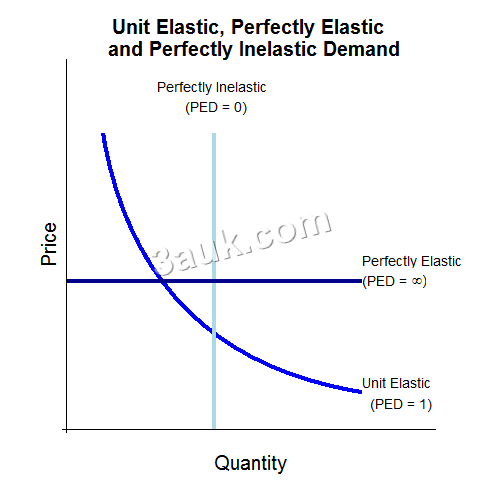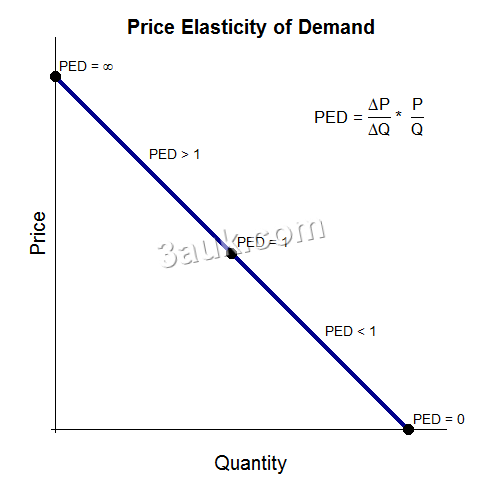Content
formulae for and calculation of price elasticity, income elasticity and cross elasticity of demand
- PED = % change in Quantity Demanded / % change in its Price
- YED = % change in Quantity Demanded / % change in Income
- XED = % change in Quantity Demanded of A / % change in Price of B
significance of relative percentage changes, the size and sign of the coefficient of PED, YED, XED
- The significance of relative percentage changes in PED, YED, and XED lies in the fact that they allow economists to determine the nature of the relationship between two variables, price and quantity demanded, income and quantity demanded, and the price of two different goods and their quantity demanded, respectively.
- PED
- A coefficient of PED greater than 1 indicates that the good or service is price elastic, meaning a small change in price will lead to a relatively larger change in the quantity demanded.
- A coefficient of PED less than 1 indicates that the good or service is price inelastic, meaning a small change in price will lead to a relatively smaller change in the quantity demanded.
- A coefficient of PED equal to 1 indicates that the good or service is unit elastic, meaning a change in price will result in an equal proportional change in the quantity demanded.
- YED
- A positive coefficient of YED indicates that the good or service is normal, meaning an increase in income leads to an increase in the quantity demanded, and a decrease in income leads to a decrease in the quantity demanded.
- A negative coefficient of YED indicates that the good or service is inferior, meaning an increase in income leads to a decrease in the quantity demanded, and a decrease in income leads to an increase in the quantity demanded.
- XED
- A positive coefficient of XED indicates that the two goods are substitutes, meaning an increase in the price of one good will lead to an increase in the demand for the other good.
- A negative coefficient of XED indicates that the two goods are complements, meaning an increase in the price of one good will lead to a decrease in the demand for the other good.
descriptions of elasticity values: perfectly elastic, (highly) elastic, unitary elasticity, (highly) inelastic, perfectly inelastic

- Perfectly Elastic: a situation where a small change in price results in an infinite change in the quantity demanded, resulting in a coefficient of price elasticity of demand (PED) equal to infinity.
- This means that consumers will switch to other available options as soon as the price of a good or service increases, leading to a horizontal demand curve.
- Elastic (Highly Elastic): a situation where a small change in price results in a relatively large change in the quantity demanded, resulting in a coefficient of PED greater than 1.
- This means that consumers are very sensitive to changes in price, leading to a flatter demand curve.
- Unitary Elasticity: a situation where a change in price results in an equal proportional change in the quantity demanded, resulting in a coefficient of PED equal to 1.
- This means that consumers are neither very sensitive nor insensitive to changes in price.
- Inelastic (Highly Inelastic): a situation where a small change in price results in a relatively small change in the quantity demanded, resulting in a coefficient of PED less than 1.
- This means that consumers are not very sensitive to changes in price, leading to a steeper demand curve.
- Perfectly Inelastic: a situation where a change in price results in no change in the quantity demanded, resulting in a coefficient of PED equal to 0.
- This means that consumers have no alternatives and must continue to purchase the good or service, regardless of its price, leading to a vertical demand curve.
factors affecting PED, YED, XED
- PED
- number of substitutes
- percentage of income spent on the goods
- nature of products: necessity (essential/important), luxury
- time horizon: take time to change habits or suppliers
- YED
- Nature of product on sale: inferior or normal
- Time factor
- Wealth distribution in society
- XED
- Substitute Goods: The relationship between two goods is often reflected in their XED, as the demand for one good may be positively or negatively affected by changes in the price of a substitute good.
- Complementary Goods: XED can also be used to measure the relationship between complementary goods, which are goods that are typically used together. For example, the demand for gasoline may be positively related to the demand for automobiles.
- Market Conditions: Market conditions, such as competition and availability of substitutes, can also affect XED, as consumers may have more or less options to choose from based on the specific market.
- Product Characteristics: Product characteristics, such as quality, versatility, and durability, can also impact XED, as consumers may be more or less likely to purchase a good or service based on these factors.
- Substitute Goods: The relationship between two goods is often reflected in their XED, as the demand for one good may be positively or negatively affected by changes in the price of a substitute good.
relationship between price elasticity of demand and total expenditure on a product
- Elastic Demand: If demand for a product is elastic, a decrease in price will lead to an increase in the quantity demanded and a corresponding increase in total expenditure.
- This is because consumers are more sensitive to price changes and are willing to purchase more of the product as the price decreases.
- Inelastic Demand: If demand for a product is inelastic, a decrease in price will lead to a smaller increase in the quantity demanded and a corresponding decrease in total expenditure.
- This is because consumers are less sensitive to price changes and are not as willing to increase their purchases of the product as the price decreases.
- Unitary Elastic Demand: If demand for a product is unitarily elastic, a decrease in price will lead to an equal increase in the quantity demanded and no change in total expenditure.
- This is because consumers are equally sensitive to price changes and the quantity demanded and total expenditure are unchanged.
implications for decision-making of price elasticity, income elasticity and cross elasticity of demand
- Price Elasticity of Demand (PED): Understanding PED can help firms make informed pricing decisions, as they can estimate the impact of a price change on demand for their product.
- If demand is elastic, a small change in price may result in a large change in demand, and the firm may choose to keep prices relatively stable.
- If demand is inelastic, a small change in price may result in a small change in demand, and the firm may choose to increase prices.
- Income Elasticity of Demand (YED): Understanding YED can help firms determine the impact of changes in consumer income on demand for their product.
- If demand is positively related to income, the firm may choose to target its marketing efforts towards consumers with higher incomes.
- If demand is negatively related to income, the firm may choose to target its marketing efforts towards consumers with lower incomes.
- Cross Elasticity of Demand (XED): Understanding XED can help firms determine the relationship between their product and substitute or complementary goods.
- If demand for a product is positively related to the price of a substitute good, the firm may choose to increase its marketing efforts to emphasize the benefits of its product over the substitute.
- If demand for a product is negatively related to the price of a complementary good, the firm may choose to increase its marketing efforts to emphasize the benefits of using its product with the complementary good.
Join the conversation
